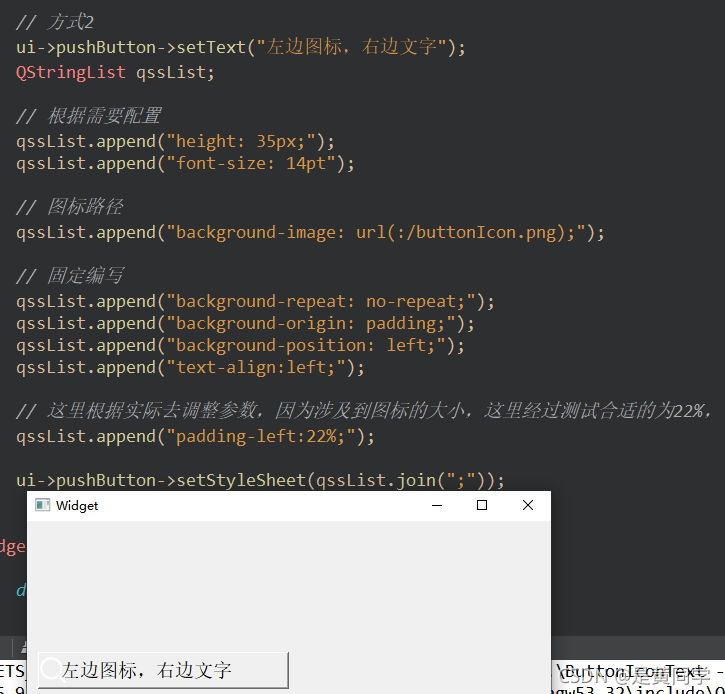一.前言
软件开发过程中,会遇到这样的需求,一个按钮要携带图标和文字,且图标在左,文字在右,以此来增强这个按钮的功能指向,这个样式在移动端还是蛮常见的,最典型就是搜索栏。
二、在Qt中有两种方式可以实现需求
方式一:代码方式
1.核心代码
`
ui->pushButton->setIcon(QIcon(":/buttonIcon.png"));
ui->pushButton->setLayoutDirection(Qt::LeftToRight);
ui->pushButton->setText("左边图标,右边文字");
`
2.效果

3.关于setLayoutDirection
官方文档是这样的:
This property holds the layout direction for this widget
By default, this property is set to Qt::LeftToRight.
When the layout direction is set on a widget, it will propagate to the widget’s children, but not to a child that is a window and not to a child for which setLayoutDirection() has been explicitly called. Also, child widgets added after setLayoutDirection() has been called for the parent do not inherit the parent’s layout direction.
大概的意思,就是这个函数是设置控件的布局方向,默认是设置从左到右的(因此在代码中,其实我们也可以不用设置,也可以实现效果),当控件设置了这个布局方向之后,他是传递到没有显示调用setLayoutDirection的子控件的,但是不会传递到作为窗口的控件,有点像向下传递而不向上传递;还有一个就是如果父控件先调用setLayoutDirection,后面再添加其他子控件,子控件是不会继承父控件的布局方向的,所以为了严谨,建议还是把setLayoutDirection加在需要设置左图标右文字的控件属性上,免得受其他控件的影响
方式二:样式表
1.核心代码以及备注
核心是样式文件的编写,这里为了简单直接在代码里面写
`
// 方式2
ui->pushButton->setText("左边图标,右边文字");
QStringList qssList;
// 根据需要配置
qssList.append("height: 35px;");
qssList.append("font-size: 14pt");
// 图标路径
qssList.append("background-image: url(:/buttonIcon.png);");
// 固定编写
qssList.append("background-repeat: no-repeat;");
qssList.append("background-origin: padding;");
qssList.append("background-position: left;");
qssList.append("text-align:left;");
// 这里根据实际去调整参数,因为涉及到图标的大小,这里经过测试合适的为22%,可以用百分比或者像素px实现
qssList.append("padding-left:22%;");
ui->pushButton->setStyleSheet(qssList.join(";"));
`
4.效果

三、例子源码